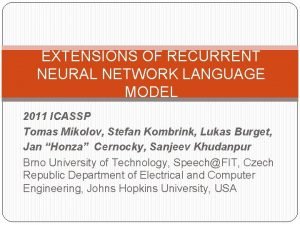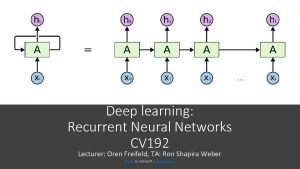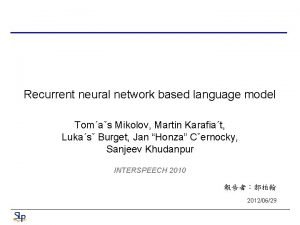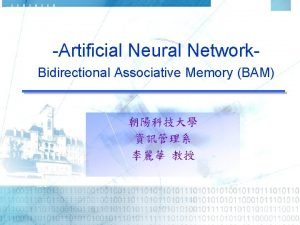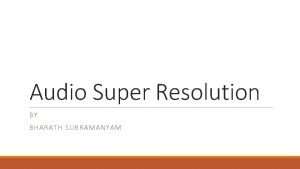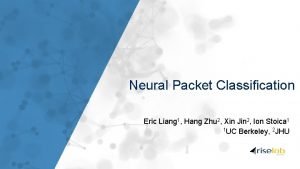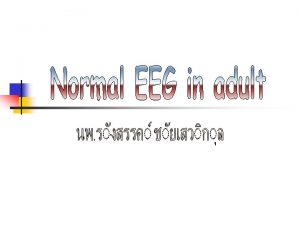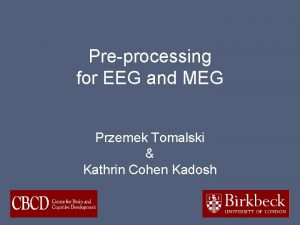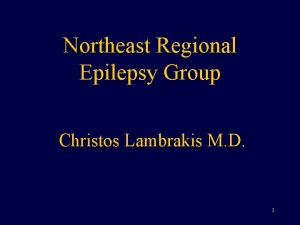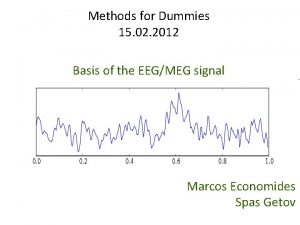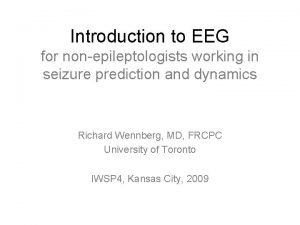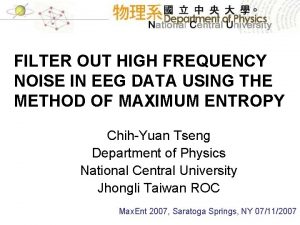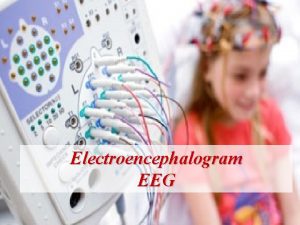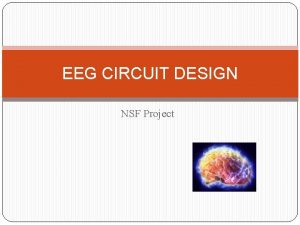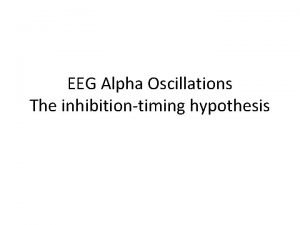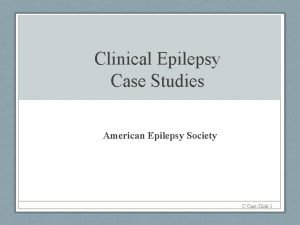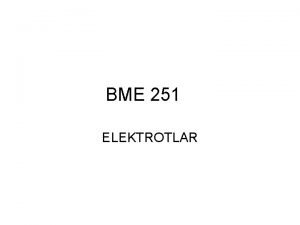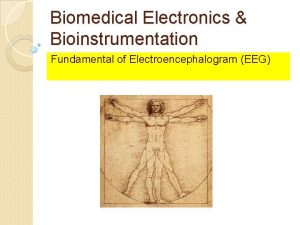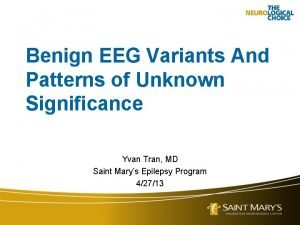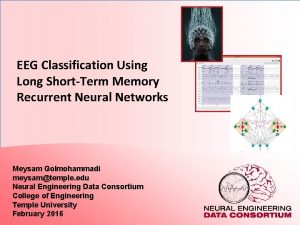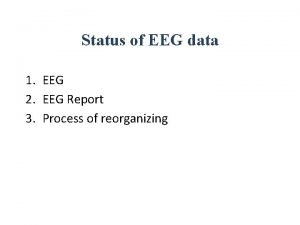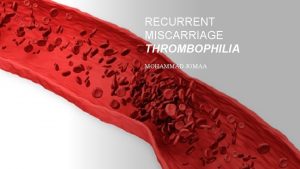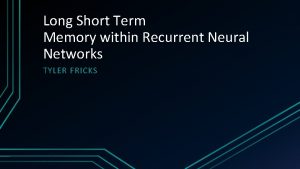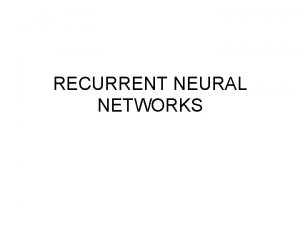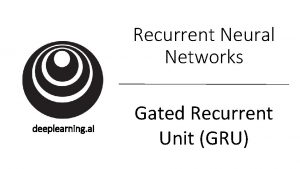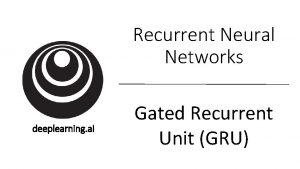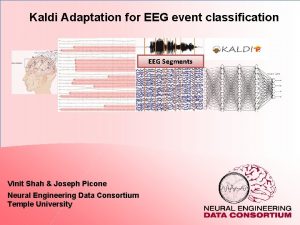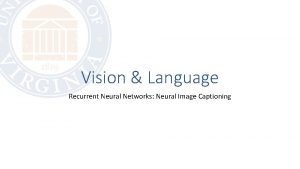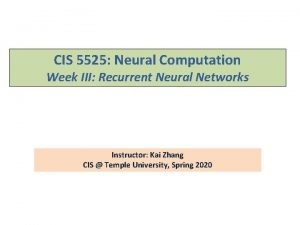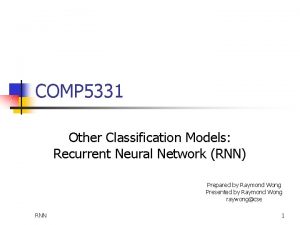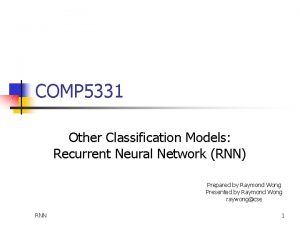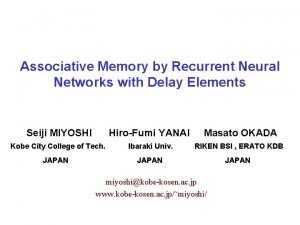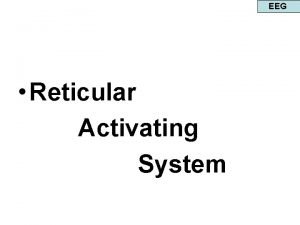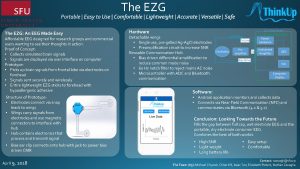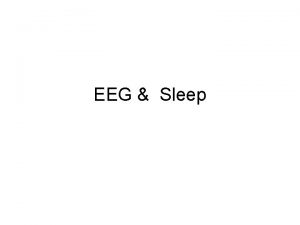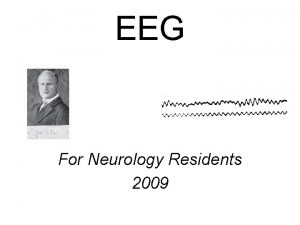EEG Classification Using Long ShortTerm Memory Recurrent Neural




























![Brief Bibliography [1] M. Hermans and B. Schrauwen, “Training and Analyzing Deep Recurrent Neural Brief Bibliography [1] M. Hermans and B. Schrauwen, “Training and Analyzing Deep Recurrent Neural](https://slidetodoc.com/presentation_image_h/ddb96d0f460de30883b6d802f256b1c2/image-29.jpg)
- Slides: 29

EEG Classification Using Long Short-Term Memory Recurrent Neural Networks Meysam Golmohammadi meysam@temple. edu Neural Engineering Data Consortium College of Engineering Temple University February 2016

Introduction • Recurrent Neural Networks • Long Short-Term Memory Networks • Deep Recurrent Neural Networks • Deep Bidirectional Long Short-Term Memory Networks • EEG Classification Using Deep Learning M. Golmohammadi: EEG Classification Using Long Short-Term Memory Recurrent Neural Networks February 23, 2015 1

Neural Networks • Generally there are two kinds of neural networks: Ø Feedforward Neural Networks: ü connections between the units do not form a cycle Ø Recurrent Neural Network: ü connections between units form cyclic paths M. Golmohammadi: EEG Classification Using Long Short-Term Memory Recurrent Neural Networks February 23, 2015 2

Recurrent Neural Network (RNN) • Recurrent since they receive inputs, update the hidden states depending on the previous computations, and make predictions for every element of a sequence. • RNNs are a neural network with memory. • RNNs are very powerful dynamic system for sequence tasks such as speech recognition or handwritten recognition since they maintain a state vector that implicitly contains information about the history of all the past elements of a sequence. M. Golmohammadi: EEG Classification Using Long Short-Term Memory Recurrent Neural Networks February 23, 2015 3

Unrolling an RNN for Sequential Modeling • M. Golmohammadi: EEG Classification Using Long Short-Term Memory Recurrent Neural Networks February 23, 2015 4

RNN Training There are different approaches for training of RNNs: • Back-Propagation Through Time (BPTT): Unfolding an RNN in time and using the extended version of backpropagation. • Extended Kalman Filtering (EKF): a set of mathematical equations that provides an efficient computational means to estimate the state of a process, in a way that minimizes the mean of the squared error on linear system. BPTT • Real-Time Recurrent Learning (RTRL): Computing the error gradient and update weights for each time step. RTRL M. Golmohammadi: EEG Classification Using Long Short-Term Memory Recurrent Neural Networks February 23, 2015 5

Backpropagation Through Time • M. Golmohammadi: EEG Classification Using Long Short-Term Memory Recurrent Neural Networks February 23, 2015 6

The Vanishing Gradient Problem • Definition: The influence of a given input on the hidden layer, and therefore on the network output, either decays or grows exponentially as it propagates through an RNN. • In practice, the range of contextual information that standard RNNs can access are limited to approximately 10 time steps between the relevant input and target events. • Solution: LSTM networks. M. Golmohammadi: EEG Classification Using Long Short-Term Memory Recurrent Neural Networks February 23, 2015 7

LONG SHORT-TERM MEMORY (LSTM) • An LSTM is a special kind of RNN architecture, capable of learning longterm dependencies. • An LSTM can learn to bridge time intervals in excess of 1000 steps. • LSTM networks outperform RNNs and Hidden Markov Models (HMM): LSTM Memory Cell § Speech Recognition: 17. 7% phoneme error rate on TIMIT acoustic phonetic corpus. § Winner of the ICDAR handwriting competition for the best known results in handwriting recognition. • This is achieved by multiplicative gate units that learn to open and close access to the constant error flow. M. Golmohammadi: EEG Classification Using Long Short-Term Memory Recurrent Neural Networks February 23, 2015 8

Memory Cell in LSTM • LSTM networks introduce a new structure called a memory cell. • Each memory cell contains four main elements: § Input gate § Forget gate LSTM Memory Cell § Output gate § Neuron with a self-recurrent • These gates allow the cells to keep and access information over long periods of time. M. Golmohammadi: EEG Classification Using Long Short-Term Memory Recurrent Neural Networks February 23, 2015 9

LSTM Equations • LSTM Memory Cell M. Golmohammadi: EEG Classification Using Long Short-Term Memory Recurrent Neural Networks 10 February 23, 2015 10

Preserving the information in LSTM • A demonstration of how an unrolled LSTM preserves sequential information. • The input, forget, and output gate activations are displayed to the left and above the memory block (respectively). The gates are either entirely open (‘O’) or entirely closed (‘—’). • Traditional RNNs are a special case of LSTMs: Set the input gate to all ones (passing all new information), the forget gate to all zeros (forgetting all of the previous memory) and the output gate to all ones (exposing the entire memory). M. Golmohammadi: EEG Classification Using Long Short-Term Memory Recurrent Neural Networks February 23, 2015 11

DEEP RECURRENT NEURAL NETWORKS (DRNN) • Standard RNN: the information only passes through one layer of processing before going to the output. • In sequence tasks we usually process information at several time scales. • DRNN: a combination of the concepts of deep neural networks (DNN) with RNNs. • By stacking RNNs, every layer is an RNN in the hierarchy that receives the hidden state of the previous layer as input. • Processing of different time scales at different levels, and therefore a temporal hierarchy will be created. M. Golmohammadi: EEG Classification Using Long Short-Term Memory Recurrent Neural Networks February 23, 2015 12

DRNN-1 O vs. DRNN-AO • Two variants of DRNN structures: § DRNN-1 O: the output will be computed just based on the hidden state of the last layer. § DRNN-AO: the output will be the combination of the hidden states of the all layers. • DRNN-AO has two great advantages: § Using BPTT for DRNN-AO, the error will propagate from the top layer down the hierarchy without attenuating of magnitude. As a result, training will be more effective. § It gives us the ability to evaluate the impact of each layer in solving the task by leaving out an individual layer’s contribution. M. Golmohammadi: EEG Classification Using Long Short-Term Memory Recurrent Neural Networks February 23, 2015 13

DRNN Equations • M. Golmohammadi: EEG Classification Using Long Short-Term Memory Recurrent Neural Networks February 23, 2015 14

DRNN Training • M. Golmohammadi: EEG Classification Using Long Short-Term Memory Recurrent Neural Networks February 23, 2015 15

Performance of DRNNs • M. Golmohammadi: EEG Classification Using Long Short-Term Memory Recurrent Neural Networks February 23, 2015 16

DEEP BIDIRECTIONAL LONG SHORT-TERM MEMORY (DBLSTM • M. Golmohammadi: EEG Classification Using Long Short-Term Memory Recurrent Neural Networks February 23, 2015 17

DBLSTM training and regularization • End-to-end training methods : § Connectionist Temporal Classification (CTC); § RNN Transducer. • Regularization: § early stopping: monitoring the model’s performance on a validation set. § weight noise: adding Gaussian noise to the network weights during training. Weight noise was added once per training sequence, rather than at every time step. M. Golmohammadi: EEG Classification Using Long Short-Term Memory Recurrent Neural Networks February 23, 2015 18

Connectionist Temporal Classification (CTC) • M. Golmohammadi: EEG Classification Using Long Short-Term Memory Recurrent Neural Networks February 23, 2015 19

Connectionist Temporal Classification (CTC) • M. Golmohammadi: EEG Classification Using Long Short-Term Memory Recurrent Neural Networks February 23, 2015 20

Connectionist Temporal Classification (Continued) • M. Golmohammadi: EEG Classification Using Long Short-Term Memory Recurrent Neural Networks February 23, 2015 21

RNN Transducers • A combination of a CTC network with a separate DBLSTM that predicts each phoneme given the previous one. • Unlike CTC which is an acoustic-only model, an RNN transducer can integrate acoustic and linguistic information during a speech recognition task and yields a jointly trained acoustic and language model. • While CTC predicts an output distribution at each input time step, an RNN transducer determines a separate distribution P(k|t, u) for every combination of input time step t and output time step u. • An RNN transducer uses two networks: § Transcription network: scans the input sequence and outputs the sequence of transcription vectors. § Prediction network: scans the output sequence and outputs the prediction vector sequence. • RNN transducers can be decoded with beam search to yield an N-best list of candidate transcriptions. M. Golmohammadi: EEG Classification Using Long Short-Term Memory Recurrent Neural Networks February 23, 2015 22

DBLSTM Performance • Phoneme recognition experiments on the TIMIT Corpus. • A bidirectional LSTM was used for all networks except CTC-3 l-500 h-tanh, which had tanh units instead of LSTM cells, and CTC-3 l-421 h-uni where the LSTM layers were unidirectional. • LSTM works much better than tanh for this task. • Bidirectional LSTMs have a slight advantage over unidirectional LSTMs. • Depth is more important than layer size. M. Golmohammadi: EEG Classification Using Long Short-Term Memory Recurrent Neural Networks February 23, 2015 23

Electroencephalograms (EEGs) • Electroencephalograms (EEGs) are used in a wide range of clinical settings to record electrical activity along the scalp. • EEGs are the primary means by which neurologists diagnose brain-related illnesses such as epilepsy and seizures. • Manual review of an EEG by a neurologist is timeconsuming and tedious. • A clinical decision support tool that automatically interprets EEGs can reduce time to diagnosis, reduce error and enhance real-time applications such as ICU monitoring. • EEG classification using deep learning: § Deep Belief Network (DBNs) § Stacked denoising Autoencoder (Sd. A) M. Golmohammadi: EEG Classification Using Long Short-Term Memory Recurrent Neural Networks February 23, 2015 24

EEG classification using DBNs • M. Golmohammadi: EEG Classification Using Long Short-Term Memory Recurrent Neural Networks February 23, 2015 25

EEG classification using Sd. As • Auto. EEG is a hybrid system that uses three levels of processing to achieve high performance event detection on clinical data: P 1: hidden Markov models P 2: Sd. A P 3: Language Model M. Golmohammadi: EEG Classification Using Long Short-Term Memory Recurrent Neural Networks February 23, 2015 26

Summary and Future Work • Deep recurrent neural networks and deep bidirectional long short-term memory have given the best known results on sequential tasks such as speech recognition. • EEG classification using deep learning methods such as deep belief networks and Sd. As appear promising. • RNNs have not been applied to sequential processing of EEG signals. • LSTMs are good candidates for EEG signal analysis: Ø Their memory properties decrease the false alarm rate. Ø CTC training allows the use of EEG reports directly without alignment. Ø A heuristic language model can be replaced by DBLSTM using an RNN transducer. Ø Prediction of a seizure event can be reported much earlier (~20 mins. ). • Future work: Ø Replace Sd. A by: Standard RNN, LSTM, DRNN, DLSTM, and DBLSTM. Ø Develop a seizure prediction tool using DBLSTM. M. Golmohammadi: EEG Classification Using Long Short-Term Memory Recurrent Neural Networks February 23, 2015 27
![Brief Bibliography 1 M Hermans and B Schrauwen Training and Analyzing Deep Recurrent Neural Brief Bibliography [1] M. Hermans and B. Schrauwen, “Training and Analyzing Deep Recurrent Neural](https://slidetodoc.com/presentation_image_h/ddb96d0f460de30883b6d802f256b1c2/image-29.jpg)
Brief Bibliography [1] M. Hermans and B. Schrauwen, “Training and Analyzing Deep Recurrent Neural Networks, ” Adv. Neural Inf. Process. Syst. , pp. 190– 198, 2013. [2] A. Graves, A. Mohamed, and G. Hinton, “Speech Recognition With Deep Recurrent Neural Networks, ” IEEE Int. Conf. Acoust. Speech, Signal Process. , no. 3, pp. 6645– 6649, 2013. [3] J. T. Turner, A. Page, T. Mohsenin, and T. Oates, “Deep Belief Networks used on High Resolution Multichannel Electroencephalography Data for Seizure Detection, ” AAAI Spring Symp. Ser. , no. 1, pp. 75– 81, 2014. [4] Y. Le. Cun, Y. Bengio, and G. Hinton, “Deep learning, ” Nature, vol. 521, no. 7553, pp. 436– 444, 2015. [5] Y. Bengio, P. Simard, and P. Frasconi, “Learning Long-Term Dependencies with Gradient Descent is Difficult, ” IEEE Trans. Neural Networks, vol. 5, no. 2, pp. 157– 166, 1994. [6] R. Pascanu, T. Mikolov, and Y. Bengio, “On the difficulty of training recurrent neural networks, ” in International Conference on Machine Learning, 2013, no. 2, pp. 1310– 1318. [7] S. Hochreiter, Y. Bengio, P. Frasconi, and J. Schmidhuber, “Gradient flow in recurrent nets: the difficulty of learning long-term dependencies, ” A F. Guid. to Dyn. Recurr. Networks, pp. 237– 243, 2001. [8] S. Hochreiter, J. Schmidhuber, and J. Schmidhuber, “Long short-term memory. , ” Neural Comput. , vol. 9, no. 8, pp. 1735– 80, 1997. [9] K. Greff, R. K. Srivastava, J. Koutník, B. R. Steunebrink, and J. Schmidhuber, “LSTM: A Search Space Odyssey, ” ar. Xiv, p. 10, 2015. [10] A. Graves and J. Schmidhuber, “Framewise phoneme classification with bidirectional LSTM networks, ” in Proceedings of the International Joint Conference on Neural Networks, 2005, vol. 4, pp. 2047– 2052. [11] A. Graves, S. Fernandez, F. Gomez, and J. Schmidhuber, “Connectionist Temporal Classification Labelling Unsegmented Sequence Data with Recurrent Neural Networks, ” Proc. 23 rd Int. Conf. Mach. Learn. , pp. 369– 376, 2006. [12] A. Graves, “Sequence transduction with recurrent neural networks, ” in ICML Representation Learning Workshop, 2012 [13] G. E. Hinton and R. R. Salakhutdinov, “Reducing the Dimensionality of Data with Neural Networks, ” Science (80. ). , vol. 313, no. 5786, pp. 504– 507, 2006. [14] Y. Bengio, P. Lamblin, D. Popovici, and H. Larochelle, “Greedy Layer-Wise Training of Deep Networks, ” Adv. Neural Inf. Process. Syst. , vol. 19, no. 1, p. 153, 2007. M. Golmohammadi: EEG Classification Using Long Short-Term Memory Recurrent Neural Networks February 23, 2015 28
 Extensions of recurrent neural network language model
Extensions of recurrent neural network language model Cs 7643 github
Cs 7643 github Rnn
Rnn Karafia
Karafia Andrew ng recurrent neural networks
Andrew ng recurrent neural networks Shortterm
Shortterm Shortterm housing
Shortterm housing Long term memory vs short term memory
Long term memory vs short term memory Tall+short h
Tall+short h Once upon a little man running
Once upon a little man running Auto associative memory
Auto associative memory Audio super resolution using neural networks
Audio super resolution using neural networks Leon gatys
Leon gatys Neural network matlab toolbox
Neural network matlab toolbox Predicting nba games using neural networks
Predicting nba games using neural networks Audio super resolution
Audio super resolution Neural packet classification
Neural packet classification K complex eeg
K complex eeg Eeg sweat artifact
Eeg sweat artifact Xl spikes on eeg
Xl spikes on eeg Eeg for dummies
Eeg for dummies Lateral rectus spikes eeg
Lateral rectus spikes eeg High frequency filter eeg
High frequency filter eeg Eeg procedure
Eeg procedure Eeg circuit design
Eeg circuit design Alpha inhibition hypothesis
Alpha inhibition hypothesis Eeg case study
Eeg case study Yüzey elektrot çeşitleri
Yüzey elektrot çeşitleri Signal amplitude of eeg
Signal amplitude of eeg Wicket rhythm eeg
Wicket rhythm eeg
